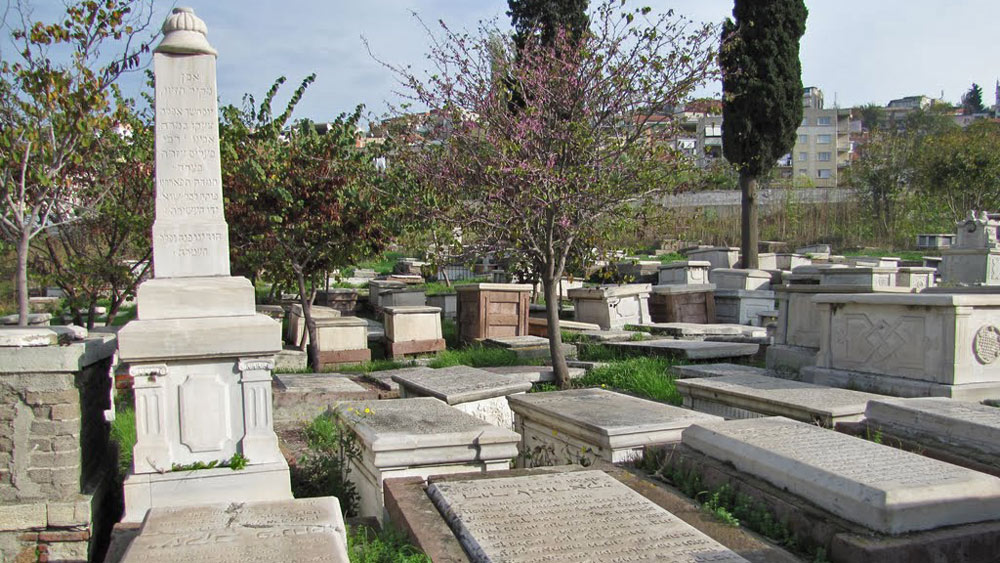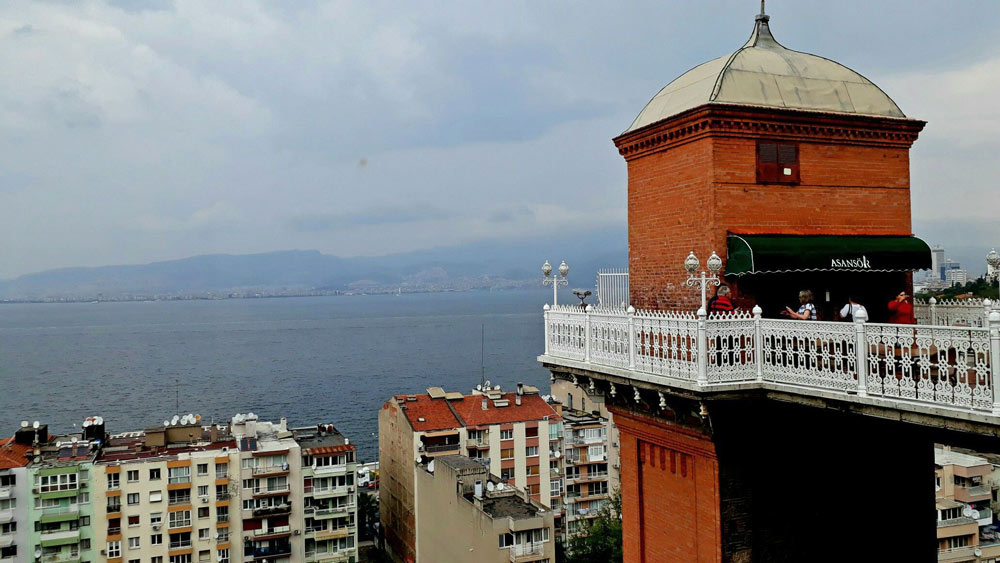Other places listed in the Jewish Heritage are; Rabbinate building, Cortijos, Sabetay Sevi’nin House, Gurcesme Jewish Cemetery and the Historical Elevator.
The Rabbinate building was built with the support from the Rotschild of Vienna in 1840. The Rabbinate building is situated in the middle of a large garden, surrounded with walls in the Street once called the Hahambasi (Chief Rabbi) Street. The Rabbinate, as the name suggests, served as the offices of the Chief Rabbinate of Izmir. Unleavened bread was made in a bakery erected adjacent to the Rabbinate in order to satisfy the needs of the Jewish community of Izmir at “Passover” holiday.
The central library and Yeshiva (theological school) of the Jewish community of Izmir had been located here and all the official affairs of the community were transacted at the Rabbinate by 1930.The Rabbinate was evicted in 1997 and an office was rented at Alsancak to carry out the affairs of the community.
Today, half of the roof of the building has collapsed and walls distorted. The Municipality of Konak is now carrying out the restoration works at the Rabbinate
The Sephardic Jews immigrated to the Ottoman Empire from the Iberian Peninsula, brought together their life styles as well as their culture. They used to live in the houses which they called family house or Cortijo in Spanish -also known as Yahudhane (Jewish house) among the local people- which consisted of a court with a faucet or well which served as the guest room and the rooms surrounding this court. Cortijos were built in the Ikicesmelik district, which is the initial area of settlement of the Jews in Izmir. Dario Moreno, who was one of the most famous personalities of the city, was also born and grew up in one of these cortijos.
Cortijos have been the meeting point of “boyoz” and “subiye” (a sherbet-like beverage made from melon seed) with the food culture of Izmir and have turned out to be one of the symbols of Izmir in the present day.
Family houses or Cortijos have not only been a type of dwelling allowing crowded families to live all together but also formed an introverted life. The court in the middle creates an introverted, intimate and private atmosphere due to the two-storied building units surrounding it on all four sides. (Tanaç, İzmir’de Sefarad Mimarisi ve Sinagogları, 2010, 164).
Jewish dwellings, as seen in the examples of Cortijos, have been formed to serve the needs of the Jews to hide from the societies in which they live and to live all together because they are a minority.
Built in the initial period when the Jewish community settled in the city of Izmir, the cortijos have not been carried over to the present day and only 5 or 6 cortijos can be counted although there were still 27 cortijos in 1982. Those cortijos built in later periods give an impression about the architecture of such dwellings. Cortijos are located in the Tilkilik Namazgah district.

Jews of Izmir had several cemeteries and the oldest one was the cemetery called Masatlik in the Bahri Baba Park. The cemetery was transferred to Gurcesme in order to satisfy the need for buildings in that part upon the growth of the city.
The Gurcesme Cemetery, which was purchased in 1885, has become the most important Jewish cemetery in Izmir. A visit to the Gurcesme Cemetery is just like taking a look into the pages of the Jewish history of Izmir. Between hundreds of tombstones scattered around, it is possible to see the tombs of the leading people of the Jewish community of Izmir. One can have access to a lot of information about the Jewish community of Izmir from some 15.000 tombstones found in cemetery. On the tombstones some of which are moderate and some of which are so magnificent, inscriptions in Turkish, Ladino, Hebrew, German and French provides information about where those people who are buried here have come from.
The tombs of Rabbi Joseph Escapa, who is the founder of the Jewish community of Izmir and died in the 17th century, Rabbi Hayim Palachi and his son Rabbi Abraham Palachi are also located here. The tomb of Hayim Palachi and the Mikve (purification pool) built by his disciples constitute the two corners of the Diamond Triangle other than Bet Hillel Synagogue. The fact that the water running from Kadifekale to the cemetery is cold in summer and warm in winter is attributed to Rabbi Hayim Palachi’s spiritual power by his disciples. The cemetery is located in the Gurcesme district.
Sabbatai Sevi was born in Izmir on 1st August 1626. His birthday was referred to as the birthday of the Messiah, who was expected to come according to the Jewish mysticism. Sabbatai Sevi’s father Mordehay Sevi is known to have come to Izmir from Peloponnessus in 1614. Sabbatai and his two brothers were born in Izmir and grew up in the house at the entrance to the Agora in the modern Ikicesmelik Street.
Sabbatai Sevi received theological education as a student of two prominent theologians Isaac Dialba and Joseph Escapa at a very young age and studied Kaballah (Jewish Mysticism) in depth. He is said to have been very intelligent and learned all the religious books by heart when he reached 18 years of age.
The great Jewish massacre which occurred in Podolia in 1648 and the persecution suffered by the Jews in various countries of Europe in the same period knocked all the Jewish communities sideways and caused them to wait for and desire the arrival of the Messiah which underlay the Sufi faith. Sabbatai Sevi declared himself the saviour of the Jews, experiencing the same sorrow in that atmosphere and believing that he was the expected Messiah in accordance with the Kaballah doctrine. His disciples called him Emire which means “Our King” or “Our Master” in Hebrew. Thereupon,
Sabbatai Sevi was alienated and driven away from Izmir by the Board of Rabbis who were his former instructors. However, Sabbatai Sevi acquired disciples not only among the Jews living in the territories of the Ottoman Empire but in the European countries and even among the Moslem and Christian populations within a few years. It is said that a great majority of the Jewish population considered him the Messiah when Sevi returned to Izmir in 1665.
Just in the course of this Messiah movement, a revolt was experienced in the streets where the Kemeralti synagogues were located and Sabbatai Sevi and his disciples frequently showed up. Thus, Izmir became the centre of the Messiah thrill.
Sabbatai Sevi was brought in the Ottoman Palace and imprisoned when the dimensions of that revolt grew. Although he converted and accepted Islam later, he remained committed to the Jewish religion during his lifetime. Part of his disciples also followed his example and
became Muslims.
The birth place of the Sabbatai-ism, whose dimensions got beyond the borders of Turkey and which has been an important subject of discussion until the present time is this house in the Ikicesmelik district. of Izmir. Sabbatai Sevi’s house has been restored by the Metropolitan Municipality of Izmir. Sabbatai Sevi’s House is located in the Ikicesmelik Street in the area of Roman Agora ruins.

By approximately 155 years ago, the Asansor cliffs were used as a stone quarry and these cliffs met the sea once upon a time. The only way to reach from the modern Mithatpasa Street to the Halil Rifatpasa Street was to climb 155 steps. In 1907, a Jewish philanthropist Nesim Levi had a 40-meter-high elevator tower built in order to facilitate the access from one street to the other. It is said that Nesim Levi Bayrakli had the elevator erected inspired by a similar elevator which he had seen in Lisbon. The elevator was first operated by steam and then by water. It is said that an average of a thousand people once used the elevator per day. Asansor is an indispensable stop for the tourists to watch the unique view of the gulf of Izmir.
Nesim Levi Bayrakli is also recalled as the person who brought the Paris fashion to Izmir. He is the one who introduced the Tocado-style hats which later became a symbol of the ladies to Izmir. Nesim Levi Bayrakli founded the Industrial Club in 1908 and was assigned with the organisation of the Exhibition of Industry in 1909.
The Asansor is accessed via the Dario Moreno lane. The musician who introduced Izmir to the world in his time, Dario Moreno bought a house in this lane with the Money he earned by singing at wedding ceremonies and entertainments at a young age and lived in this house together with his mother for a while. This lane also known as 302nd lane was renamed Dario Moreno lane in 1990 due to his contribution to the Turkish pop music . The elevator is located in the Karatas district.